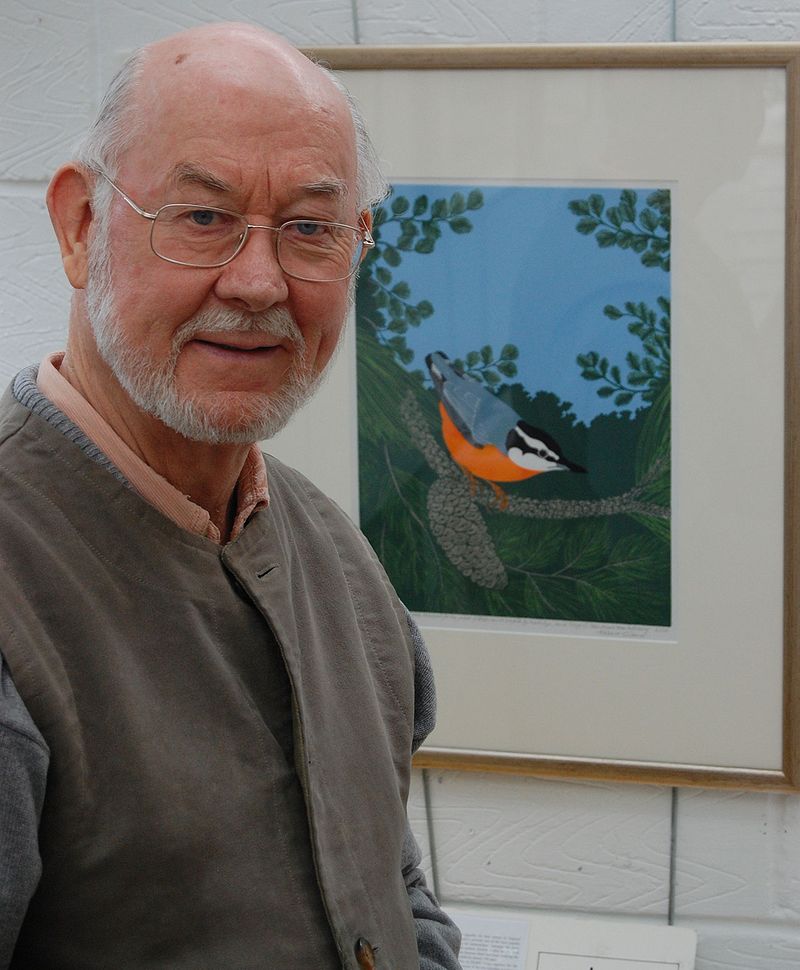
Robert Gillmor, one of Britain’s best known and most loved wildlife artists passed away yesterday, aged 85 (birthday, 6 July).
Gillmor’s work is familiar to many generations of professional and amateur naturalists – many of us grew up with it. His clear lines, tasteful composition and love of species with bold patterns make his work instantly recognisable. Over the years, his work has appeared on tea towels, calendars, greetings cards, the covers of a huge number of New Naturalist volumes, in ornithological journals (where his first appearance in British Birds was in 1952), on postage stamps and gracing the walls of many galleries.
Readers of this blog may well have seen him, and talked to him for he was very approachable, at a string of Bird Fairs (in the Art Marquee), at Society of Wildlife Artist (SWLA) exhibitions (he was a founder of SWLA (with Eric Ennion) and later its secretary, chair and served two terms as president) and for many years at RSPB member weekends. At those RSPB events, many at York University, Robert held practical workshops and mid-afternoon, in favourable weather, there would be budding artists dotted over the campus getting tips on their work and treasuring all words of appreciation from the master. Robert designed the original RSPB Avocet logo and in 2001 was awarded the RSPB Medal. I was sitting next to him when he returned to his seat with the box, opened it and looked at the medal and said, ‘Ah yes, I’d forgotten I designed this. How nice.’. Robert was generous with his time to a wide range of organisations including the SWLA, RSPB, BTO and BOU, and he was the art editor for the Birds of the Western Palearctic. Indeed, he was generous to all.
His schooling was at Leighton Park School in Reading, a Quaker school, and after taking a degree in Art from Reading University he returned to Leighton Park to teach art. He ‘retired’ from teaching in 1965 and once told me that he had been ‘mucking about’ ever since. That mucking about involved exploring birds as artistic subjects. In recent years Robert had returned to linocuts and print-making as a favoured technique, well suited to bold patterns.
Robert married Sue in 1974 and they moved to Cley in Norfolk in 1998 after their children, Emily and Thomas, had ‘fledged’.

I interviewed Robert for my book (with Keith Betton) Behind the Binoculars (published 2015) and there he talked about his childhood and the influence of his artist grandfather Allen Seaby, his time at Leighton Park first as a pupil and then as a teacher, the setting up of the SWLA, the positive influence of photography on wildlife art and the need for wildlife artists to pay the bills as well as produce fine artwork. Robert was a birdwatcher from a very early age. Two Turnstones by Robert grace the cover of that book.
Robert Gillmor’s contribution to wildlife art and the wider ornithological and conservation scene was immense. Not only was he a highly talented and prolific illustrator and artist but he gave his time, expertise and thoughts freely whenever he was consulted. He has made a difference, a very positive one, to many lives through that generosity as well as through his artwork over eight decades. When many of us see a Ringed Plover on a beach or a Bullfinch on a hedge we will sometimes think ‘That bird looks just like a Gillmor’.
[registration_form]
I remember Robert’s paintings from when I first joined YOC and then RSPB, where he was such an incredible influence – expressing the beauty of birds to so many people. If anyone epitomised the role of art in conservation it was Robert. An incredible talent and influence matched by an extraordinary modesty. He will be sorely missed.
A wee bit embarrassed to say I recognise the art, but didn’t know the name of the artist. Yes his style is very distinctive and beautiful. Thank you for a lovely and illuminating description of the life of what was clearly a very good man and conservationist.
I remember Gillmor through my close friendship with bird artist and falconer, the late Ken Wood. Ken became Secretary (or was it treasurer?) of the SWLA and the preview of the society’s annual exhibition at the Mall Galleries was a chance to see Gillmor’s stunning work at close hand. Thanks to Ken I was privileged to have chats with him. He was amazing in all aspects. There are bad, average, good and great wildlife artists; he was one of the latter. Who does everyone think now replaces him at the top of the tree?
Only just caught up with this sad news. As well as being an outstanding artist, he was a lovely, thoughtful and gentle man.
Robert Gillmor came to talk to our RSPB group in 1989. We put him up for the night and next morning I put Eric Simms book ‘A Natural history of British birds’ which Robert had illustrated, on the table and asked him to sign it. I went out to the kitchen to prepare his breakfast and when I came back not only was the book signed but above it a delightful pen and ink drawing of an avocet all accomplished in no more than 10 minutes. What a charming and talented man. RIP
I think I’m correct in saying that as well as the RSPB logo, Robert also designed the Devon Birdwatching and Preservation Society (now more commonly called Devon Birds) logo of a Montagu’s Harrier in 1968, of all bird artists he always managed to get the ‘jizz’ of any bird in his art, the DBWPS has since ‘updated’ their logo of a Montagu’s Harrier, but some old members will probably remember the old logo and some may even have a society tie exactly as I have.
A fine artist sadly lost. He could draw the wind! Amazing! But he could do it.